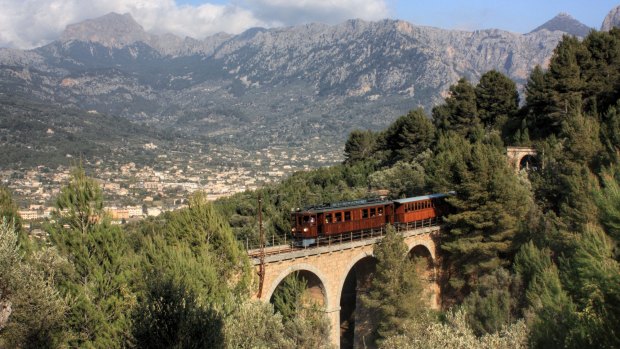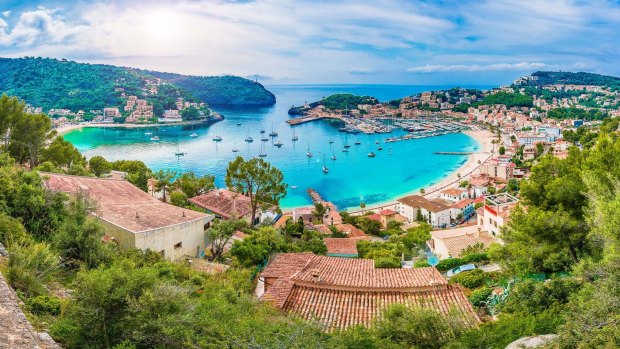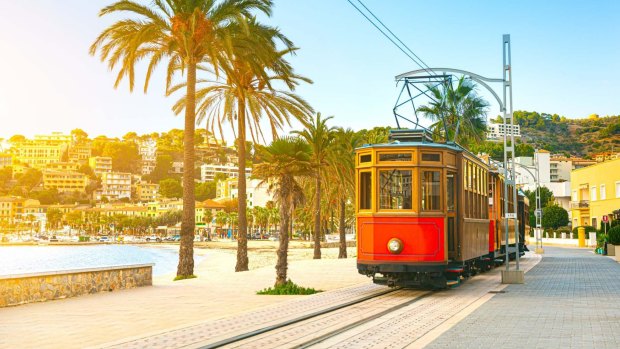This was published 2 years ago
Train to Soller from Palma, Majorca, Spain: On board 'The Orange Express'

The Tren de Soller, it connects Palma, Majorca's vibrant capital, with the postcard-pretty rural town of Soller.Credit: Alamy
The morning began with us gazing at the blue Mediterranean, sparkling under the rising sun, from our cruise ship balcony. Now we're on a train clickety-clacking through what resembles the Old West, the parched landscapes scoured with craggy peaks as hazy parcels of smoke simmer from patches of arid farmland beside the tracks. The Americana vibe is further fuelled by the couple next to me. "Looks like West Texas," drawls the man. "Yep. More trees, though," says his wife.
We're actually trundling into the mountainous interior of Majorca, the largest of Spain's Balearic islands. And the scenery, visible through the rolled-down windows of our polished wood-panelled train carriage, grows increasingly leafier, and classically Mediterranean.
We spot almond trees, carobs (great for the local herbal liqueurs, apparently), olive trees on tiered dry-stone terraces, distant thickets of pine and, later, citrus groves galore, some so close you could probably grab fruit from the branches if you fancied chancing your arm. This train isn't known as "The Orange Express" for nothing.

Porte de Soller, Palma Mallorca, Spain. Credit: iStock
Officially the Tren de Soller, it connects Palma, Majorca's vibrant capital, with the postcard-pretty rural town of Soller (on this shore excursion with Norwegian Cruise Line, we're transferred by coach from Palma's port and board the train at a dusty, outback-like stop just beyond the city limits). Inaugurated on April 16, 1912 - the day the world learned of the Titanic's sinking - this narrow-gauge railway was bankrolled by the businessmen of Soller, whose citrus trade was hampered by the town's isolated inland location, cut off from Palma by brooding mountains.
Electrified in 1929, the line stretches 27 kilometres via bridges, viaducts and tunnels, hastening a journey previously made over a mountain pass by animal-hauled stagecoaches loaded with lemons and oranges. Near the end of our hour-long ride, we emerge from the longest (almost three-kilometre) tunnel and stop to survey Soller from a panoramic mirador or lookout. It sits in a bowl-shaped valley, dwarfed by the mountains of the Serra de Tramuntana (which reach 1445 metres in height).
Soller's name is said to derive from an Arabic word, "Suljer", meaning "golden valley", and harks back to the Muslim Moors, who occupied Majorca in the Middle Ages. The Moorish legacy infuses the island still, from its dialects and irrigation systems to its cuisine and annual celebrations.

The famous orange tram runs from Soller to Port de Soller, Mallorca.Credit: iStock
Each May, for instance, Es Firo: the Festival of Moors and Christians (Moros y Cristianos), stages parades, fireworks and mock battles in Soller and neighbouring seaside resort-village, Port de Soller. A tram, launched in 1913, links the pair, departing from outside Soller's quaint train terminal.
The tram rattles past us and Soller's main plaza as we stroll into the laid-back historic centre, where townsfolk and tourists sip alfresco coffees and refreshments mined from the famously sweet and juicy local oranges. Mounds of these plump delights rest in baskets outside little bars and shops that sell freshly-squeezed orange smoothies, tangy ice cream, marmalade and orange balsamic vinegar.
Monika, our Polish-born Majorcan guide, reveals how the citrus riches helped fund not just Soller's charming transport, but its eye-catching architecture too. We admire decorative old houses built for French merchants in styles that were fashionable in Paris, and landmarks steeped in Catalan Modernism, the Spanish variant of art nouveau.
The Bank of Soller - which would blend seamlessly into Barcelona's streetscape - was crafted by Joan Rubio, a disciple of Antoni Gaudi. Rubio also redesigned the facade of the 13th-century Saint Bartholomew church next door. Incidentally, Soller's railway station exhibits artworks from Pablo Picasso and Joan Miro.
We have another half-hour or so to explore Soller by ourselves. I mosey around the narrow side streets, with their green window shutters and vintage lamps, and jacaranda, bougainvillea, palm and orange trees blooming from the gardens of bed and breakfasts and private homes.
You could imagine staying a few more days, enjoying hikes and bike rides in the surrounding (UNESCO World Heritage-listed) countryside, evening tapas on the plaza, and fossicking for artisan produce at the town's weekly Saturday market.
But enough daydreaming. That's for another time, perhaps. Now we must hop on a coach back to our ship in Palma and continue our Mediterranean adventure.
TRIP NOTES
MORE
CRUISE
Norwegian Epic visits Palma on 7-night Mediterranean cruises departing Rome or Barcelona. For April 2022 sailings, balcony staterooms are priced from around US$1532 (AU$2192) per person. Norwegian's Soller train shore excursion is $US125. See ncl.com
Steve McKenna was a guest of Norwegian Cruise Line.
Sign up for the Traveller Deals newsletter
Get exclusive travel deals delivered straight to your inbox. Sign up now.